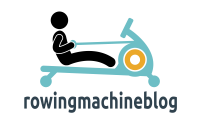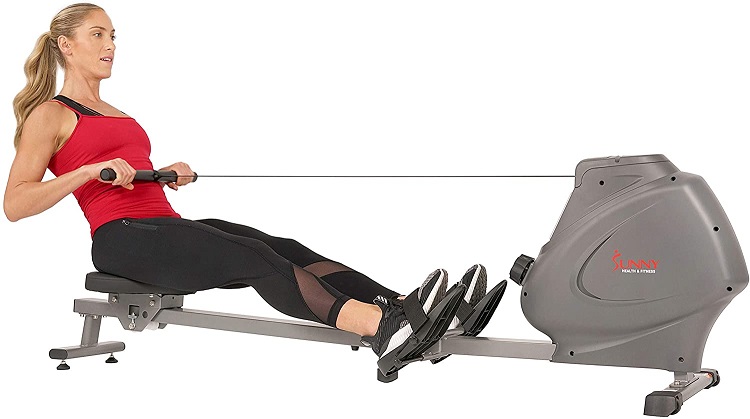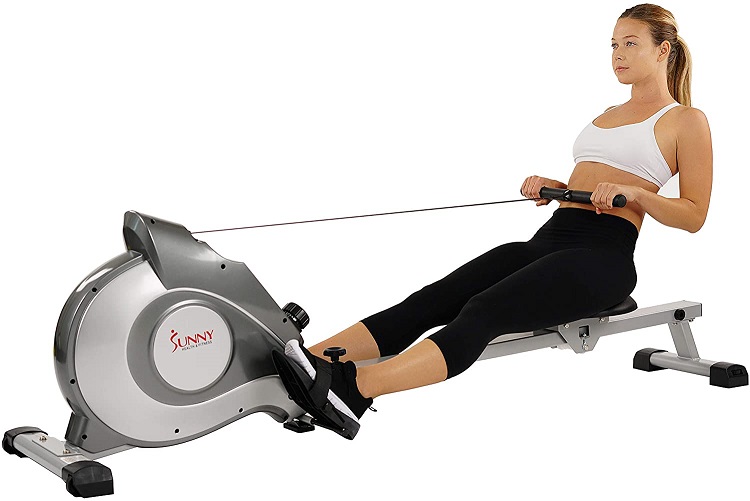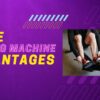Top 20 Health Benefits From Rowing According to Scientific Studies
Rowing is a fantastic form of exercise that has numerous health benefits from increased strength and stamina to burning calories by the dozen. Also known as an ergometer, the indoor rowing machine is a standard in most gyms and provides a killer workout that will have you looking lean and mean in no time.
What Is an Indoor Rowing Machine?
The indoor rowing machine or ergometer is essentially a piece of the gym or home equipment that mimics the actions of rowing a boat, canoe, or shell (as in the Olympics). This machine has multiple purposes that can be used for a variety of training from low-impact workouts and low-intensity endurance development to high-intensity sprint intervals, full-body strength training, core training, and posture control.
How Do You Use a Rowing Machine?
A rowing machine imitates the actions used when rowing a small boat, using the arms, legs, and core of the body. An easy way to row is to use this simple formula: push, core, pull, relax and repeat. The motion of rowing begins at the bottom of the stroke in the catch position with the knees bent and arms holding the handles in front of the body.
The legs are then extended, using the quad muscles to push away from the base of the machine while at the same time, hinging the core and using the arms to pull the handle towards the chest. Once the legs are extended, bends the knees again and move back to the starting position. Repeat the movement. The bulk of the rowing movement is in the legs and is made up of 60% legs, 30% core, and 10% arms if done correctly.
Table of Contents
To get the most benefit out of your rowing workout, the core must be activated and hinged correctly – like when you are doing a deadlift. The core must be engaged at all times during your rowing workout and the abdomen muscles must be dynamically engaged.
20 Benefits of Rowing Machine Workouts
1. Burns Calories
Rowing combines cardiovascular and strength training and burns large amounts of calories depending on your body weight and the effort you put in. Rowing can burn between 400 and 500 calories in an hour. Competitive rowers burn almost twice as many calories over 2,000 meters as runners burn over 3,000 meters.
2. Reduces Stress
Physical activity, like rowing, helps produce endorphins, the feel-good chemicals in your brain. Endorphins help with insomnia and help you to sleep better; they act as natural relaxants and painkillers; and generally, make you feel great! Regular sessions on your rowing machine will lift your mood, reduce stress, and improve your self-esteem.
3. Improves Cardiovascular Fitness
Rowing is a cardiovascular exercise that uses both the arms and legs, as well as the core and back to propel the body forward. It tones the lower and upper body, and the core, and produces better overall muscle definition than other cardio activities like running. Rowing regularly can help increase your stamina and endurance, as well as overall aerobic and cardiovascular fitness.
4. Heart Healthy
Rowing is a cardiovascular exercise and one of the best exercises for maintaining a happy and healthy heart. Cardiovascular exercise helps to get the heart pumping, muscles working, and sweat flowing and helps make the heart stronger. The heart is the engine of the body and the core of the complex and hard-working cardiovascular system, which also includes the vast network of arteries, veins, and other blood vessels that run throughout the body, taking oxygenated blood to every cell.
5. Tones Muscles
Rowing works the muscles in the arms, legs, back, and core, building lean muscle, as well as toning, and tightening flabby muscles, leaving the body looking lean and mean. Rowing builds and strengthens muscles without putting any strain on the musculoskeletal structure and helps to target muscle groups that wouldn’t normally be used in other exercises. It also helps flex and stretch the muscles, which is great for people of all ages to fend of the stiffening effects of aging.
6. Strengthens Your Core
Rowing makes your core stronger by working the neutralizer and stabilizer muscles, which are the same muscles that create balance within the body and prevent you from injuring your back when you pick up something heavy.
7. Improves Flexibility and Mobility
A 20 to 30-minute session of moderate rowing will loosen joints and muscles and increase flexibility. The repetitive stretching actions of rowing help keep the body flexible and also helps to reduce stiffness post-exercise.
8. Low Impact on the Joints
Rowing is to be low-impact, using fluid motions that are non-weight bearing on the joints and tendons.
9. Good Cross-Training Exercise for Other Sports
Rowing is a great cross-training exercise that benefits an array of other sports like swimming, running, tennis, and squash. Because it works so many muscle groups in the body, rowing strengthens and tones the arms, legs back, and core and helps most forms of other training.
10. Rowing Machines are Easy to Use
Have you ever walked into a gym and felt overwhelmed by all the different types of equipment? Or even worse, started on a machine, only to be told halfway through that you are back to front and upside down? A rowing machine is easy to use from setting it up for your body and exercise requirements to using the machine.
11. Good for Arthritis and Osteoarthritis
For anyone who suffers from osteoarthritis or arthritis, rowing is an excellent way to stay in shape. It’s also a good form of exercise if you’re recovering from an injury or battling with other aches and pains. A rowing machine will help you strengthen your joints and increase mobility without causing more damage.
12. Rowing is Beginner-Friendly
Rowing is an easy way to start working out in the gym or at home as it is easy to perform and can be built up to varying levels of resistance. Rowing can show results in a short time for both beginners and more advanced rowers, so stick with it and you’ll see the results.
13. Improves Posture
Rowing is an excellent form of exercise to improve posture if done correctly without slouching or over-compressing when you pull back. It requires a straight strong back and core and this can lead to a marked improvement in posture over time.
14. Rowing is Versatile
Rowing is a very versatile form of exercise that combines cardiovascular, strength, and fat-burning training. Rowing at lower intensities for a longer period can build endurance and stamina, while rowing at high intensities for short periods with set intervals is great for building speed, increasing heart rate, and overall fitness.
15. Improves Circulation
Rowing improves circulation and helps the heart to pump oxygenated blood to all parts of the body, move nutrients around for cell repair, and remove cell waste quickly and efficiently. A healthy circulatory system reduces the risk of embolisms, blockages caused by blood clots that typically form in the veins in the legs and travels to the heart and the lungs, which can be deadly. Improved circulation can also reduce the risk of strokes and other circulatory problems.
16. Helps with Brain Functioning
Regular exercise, such as rowing, improves cognitive functioning, memory, and thinking skills. Rowing increases the heart rate, which increases the blood flow to the brain, and reduces inflammation and insulin resistance in the brain, which supports the growth of new brain cells.
17. Quick and Easy
No more long hours in the gym…rowing is a quick and easy form of exercise that can give you a full-body workout in just 15 minutes!
18. Easy on the Wallet
Rowing is an inexpensive form of exercise with the only cost outlays being a gym membership (if you don’t already have one) or the cost of a rowing machine for home. You don’t need any specific training gear – you can simply wear shorts and a tee and trainers and there are no other extra costs involved.
19. Challenging and Motivating
Rowing machines can be set at different levels as a challenge, which is also a good motivator to train hard. It’s a form of exercise in which you see fast results, which is also a great motivator to train harder.
20. Good Practice for Rowing Outdoors
Rowing in the gym can also set you up to try it outdoors. You can join a rowing club and meet new like-minded people while at the same time enjoying the fresh air and beautiful scenery that surrounded most rowing locations.
Can Rowing Be My Entire Workout Every Time?
Rowing can most definitely be used as a single workout as it provides an excellent full-body workout and works the cardiovascular, respiratory, and circulatory systems. The intensity of the workouts can be increased as you get fitter and stronger and molded to your body’s specific needs.
Final Thoughts
Rowing is a fantastic form of exercise that is easy to do for all levels, versatile, and inexpensive. It has a wealth of benefits from improving heart health, circulation, lung capacity, and posture to reducing stress, helping with flexibility, increasing strength and stamina, and more. Happy rowing!
-
This article is courtesy of SportFitness Advisor.com, where the content is backed up by scientific research hoping to help people in various positions from the fitness spectrum by promoting positive health changes through diet and exercise.
As with anything you read on the internet, this article should not be construed as medical advice; please talk to your doctor or primary care provider before making any changes to your wellness routine
Content may be edited for style and length.
Materials provided by:
https://www.sport-fitness-advisor.com/rowing-benefits.html
https://www.afpafitness.com/research-articles/a-quick-and-easy-guide-to-indoor-rowing-machines
https://www.ncbi.nlm.nih.gov/pmc/articles/PMC4564707/
https://www.ncbi.nlm.nih.gov/pubmed/25226943
https://www.ncbi.nlm.nih.gov/pmc/articles/PMC5260651/#!po=72.2222
https://doi.org/10.3233/BME-141056
https://dx.doi.org/10.5535%2Farm.2015.39.4.592
https://doi.org/10.1007/s00421-002-0599-z
Benefits From Rowing, According to Science | Worldhealth.net Anti-Aging News
If you are interested in taking up indoor rowing exercise to improve your health benefits from rowing then you can check our recommended range of indoor rowers reviewed here
Our team would love to share more fitness related content towards your goals, lifestyle and budget and you can subscribe to be notified and receive these new posts if you sign up below.




















